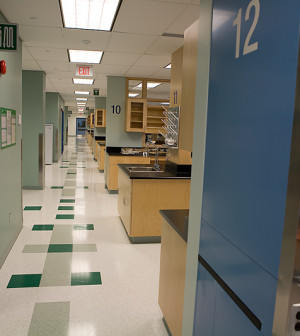- Skip Storing This Everyday Product in the Fridge Door
- Green Tea + B3 Pairing May Boost Brain Health
- Navigating Your Midlife Crisis: Embracing New Possibilities
- City Raccoons Showing Signs of Domestication
- Mapping the Exposome: Science Broadens Focus to Environmental Disease Triggers
- One Week Less on Social Media Linked to Better Mental Health
- Your Brain Changes in Stages as You Age, Study Finds
- Some Suicide Victims Show No Typical Warning Signs, Study Finds
- ByHeart Formula Faces Lawsuits After Babies Sickened With Botulism
- Switch to Vegan Diet Could Cut Your Greenhouse Gas Emissions in Half
Study Questions Close Monitoring of Thyroid Growths


Harmless growths in the thyroid gland are common, and a new study suggests they don’t need to be monitored as closely as current guidelines recommend.
The thyroid is a gland in the neck that secretes hormones involved in metabolism. According to the American Thyroid Association, by age 60 about half of all people develop a thyroid nodule, an abnormal lump of cells within the gland.
Most nodules cause no symptoms, the association says, and they are only detected by chance, when someone has an imaging test for an unrelated reason — such as a CT scan of the chest or an ultrasound of the carotid arteries in the neck.
If the nodule is large enough, doctors will do a biopsy — using a fine needle to extract some cells — to see whether the lump is cancerous. More than 90 percent of the nodules are deemed benign, or harmless, the association says.
“But the question still is, what if that [biopsy result] is a false-negative?” said Dr. Anne Cappola, an endocrinologist at the University of Pennsylvania.
Because of that, thyroid association guidelines say that people with benign nodules should get follow-up ultrasound scans after one year, and then “periodically” after that, said Dr. Hossein Gharib, a past thyroid association president and a professor of medicine at the Mayo Clinic in Rochester, Minn.
If the nodule grows by about 50 percent in volume, guidelines say a repeat biopsy should be done, Gharib said.
But the new study, published March 3 in the Journal of the American Medical Association, challenges the need for such close monitoring in many cases.
Italian researchers followed nearly 1,000 patients with presumably benign thyroid nodules. All patients had either had a biopsy, or had skipped the biopsy because an ultrasound showed their nodules to be tiny and free of suspicious features that could signal cancer.
Over five years of monitoring with yearly ultrasound scans, most patients’ thyroid nodules showed no substantial change. For 15 percent, the nodule grew by 50 percent in volume, while it shrank for 19 percent.
Most important, only five nodules — or 0.3 percent — were eventually diagnosed as thyroid cancer, the investigators found.
Cappola, who wrote an editorial published with the study, called the findings good news.
“Patients diagnosed with benign nodules should all feel reassured that during the follow-up period, the likelihood of finding cancer is very low,” Cappola said.
But, she added, the results also suggest that the current approach of monitoring patients is “not the most efficient way” to catch the small number who really have thyroid cancer.
“We’ve probably been too aggressive with follow-up,” Cappola said.
Dr. Sebastiano Filetti, the lead researcher on the study, agreed with both points. “Our findings should be reassuring to patients whose nodules appear to be benign based on the initial [biopsy] or on ultrasound findings,” said Filetti, a professor of internal medicine at the University of Rome Sapienza.
The findings also suggest that benign nodules can be “safely managed” with an ultrasound scan one year after the initial diagnosis, Filetti said. If there are no concerning changes, patients could go another five years without an ultrasound, he said.
Another issue is that the current guidelines consider 50 percent growth in a nodule to be a “trigger” for a repeat biopsy. But Cappola said that growth does not seem to be a good indicator that something is amiss. Of the few patients in this study who were later found to have cancer, the majority did not show much growth in the nodule.
Instead, the nodules showed certain “suspicious features” during ultrasound, Cappola pointed out.
“It’s not about growth,” she said. “Because benign nodules grow, too.”
Because of that, she said, repeat biopsies should be done based on whether a nodule has concerning features.
Gharib, the former thyroid association president, said he thinks the findings are generally in line with the group’s guidelines. He also pointed out that the rate of false-negatives with nodule biopsies varies from one medical center to another, depending on the center’s experience, so the low rate in this study would not necessarily be true everywhere.
However, the thyroid association is in the middle of updating its guidelines, Gharib said.
For patients confused by it all, Cappola recommended they talk to their doctors about how much follow-up is really necessary.
“It always comes down to a discussion about what you, as an individual, need,” she said.
More information
The American Thyroid Association has more on benign thyroid nodules.
Source: HealthDay
Copyright © 2025 HealthDay. All rights reserved.










